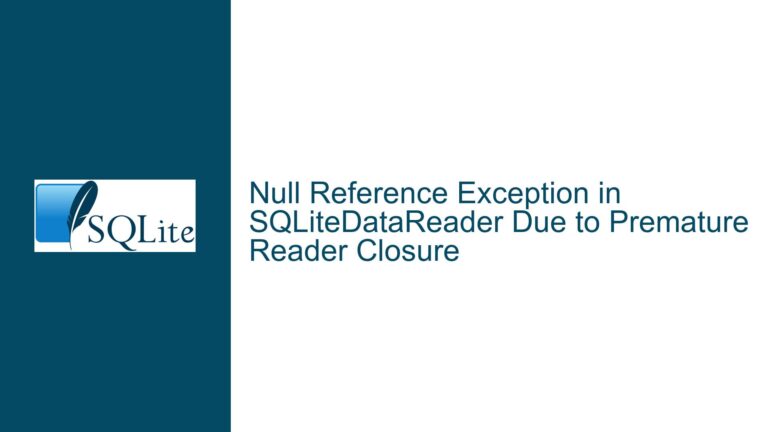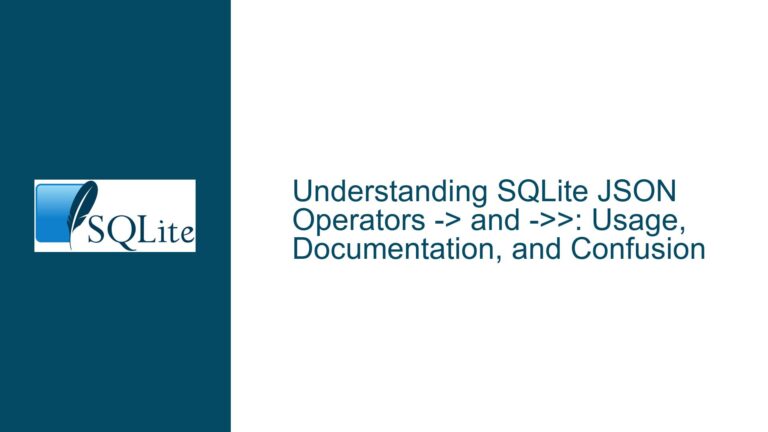Assertion Failure in RIGHT JOIN with View on WITHOUT ROWID Table
Understanding the Assertion Failure in sqlite3VdbeExec
This guide addresses the assertion failure triggered during the execution of a SQL query involving a RIGHT JOIN on a WITHOUT ROWID table and a view. The error manifests as a crash with the message Assertion 'pC!=0' failed in the sqlite3VdbeExec function. We dissect the root causes, explore the technical relationships between the components, and provide actionable fixes.
Components Involved in the Failure
1. The Query Structure and Schema Design
The failure occurs when executing a query that combines:
- A
WITHOUT ROWIDtable (v0) with a primary key onc1. - A view (
v2) defined as a simpleSELECTonv0. - A
RIGHT JOINbetween two aliases ofv0and a join with the viewv2, filtered by aWHEREclause involvinga0.c1.
The query’s complexity stems from:
- Self-referential joins: The table
v0is aliased asa1and joined with itself. - View usage in joins: The view
v2(aliased asa0) is treated as a table in theJOINclause. - Mixed join types: A
RIGHT JOINcombined with anINNER JOIN(implicit inJOIN v2 a0).
2. The Assertion Failure Context
The error pC!=0 indicates a null cursor (pC) being accessed in the virtual database engine (VDBE). A cursor in SQLite represents an open handle to iterate over database records. The assertion enforces that cursors must always be valid during execution.
Key observations:
- The failure occurs during query execution, not parsing or preparation.
- The
WITHOUT ROWIDtable and view introduce schema-specific optimizations. - The compilation flags (e.g.,
SQLITE_COUNTOFVIEW_OPTIMIZATION,SQLITE_ENABLE_STAT4) alter query planner behavior.
3. Compilation Flags and Debugging Features
The user’s build includes flags that enable:
- Debugging tools:
SQLITE_DEBUG,SQLITE_ENABLE_TREETRACE, andSQLITE_ENABLE_WHERETRACE. - Cursor hints:
SQLITE_ENABLE_CURSOR_HINTSfor query planner optimizations. - Statistics and optimizations:
SQLITE_ENABLE_STAT4(improved query planner decisions) andSQLITE_COUNTOFVIEW_OPTIMIZATION(view-specific optimizations).
These flags expose internal behaviors but may also destabilize edge cases, especially when combined with complex queries.
Root Causes of the Assertion Failure
1. Invalid Cursor Initialization in Joins
The RIGHT JOIN operation in SQLite is internally transformed into a LEFT JOIN by swapping table operands. During this transformation, the cursor assignments for the right-hand table (now the left operand) might not be properly initialized when combined with a view.
Specific failure pathways:
- The view
v2is materialized as a subquery, but its cursor is not allocated due to an optimization oversight. - The
WHERE a0.c1clause forces a filter on the view’s column, which may bypass cursor initialization if the planner incorrectly assumes short-circuit evaluation.
2. View Optimization Conflicts
The SQLITE_COUNTOFVIEW_OPTIMIZATION flag enables optimizations for COUNT(*) queries on views. While the user’s query does not use COUNT(*), this flag may inadvertently alter how the view v2 is processed in joins. For example:
- The optimizer might treat
v2as a simple pass-through tov0, ignoring edge cases where the view’s cursor is required forRIGHT JOINresolution. - If the view’s cursor is optimized out, subsequent operations referencing it (e.g.,
a0.c1 ISNULL) trigger the null cursor assertion.
3. WITHOUT ROWID Table Interactions
WITHOUT ROWID tables store data as a clustered index, which changes how cursors traverse records. When joined with a view, the query planner may generate a cursor configuration that assumes rowid-based access, leading to mismatches.
Example scenario:
- The primary key cursor for
v0is reused for the viewv2, but theRIGHT JOINrequires a separate cursor for the view’s aliasa0. - The planner fails to allocate a new cursor for
a0due to an index-sharing optimization, resulting inpC=0.
Diagnostic and Resolution Strategies
1. Query Simplification and Isolation
Step 1: Remove the RIGHT JOIN
Test the query with INNER JOIN or LEFT JOIN instead. If the assertion disappears, the issue is specific to RIGHT JOIN handling.
Step 2: Materialize the View
Replace v2 with a direct reference to v0 to isolate view-related issues:
SELECT * FROM v0 RIGHT JOIN v0 a1 JOIN v0 a0 ON (a0.c1 ISNULL) WHERE a0.c1;
If this succeeds, the view’s definition or optimization is the culprit.
Step 3: Disable Optimizations
Recompile SQLite without SQLITE_COUNTOFVIEW_OPTIMIZATION and SQLITE_ENABLE_STAT4. If the error resolves, one of these flags interacts poorly with the query.
2. Query Planner Analysis
Use EXPLAIN and EXPLAIN QUERY PLAN to inspect cursor assignments:
EXPLAIN QUERY PLAN
SELECT * FROM v0 RIGHT JOIN v0 a1 JOIN v2 a0 ON (a0.c1 ISNULL) WHERE a0.c1;
Look for:
- Missing
OpenEphemeralorOpenReadopcodes for the viewv2. - Cursor numbers reused across multiple tables or aliases.
3. Patch Application and Version Testing
The user referenced patches (4c5a3c5fb351cc1c, 1ba22631a7831e35). Apply these to the SQLite source and re-test. These patches likely address cursor allocation in nested joins involving views.
4. Schema Refactoring
Option 1: Avoid WITHOUT ROWID
Test with a rowid table:
CREATE TABLE v0 (c1 PRIMARY KEY); -- Remove WITHOUT ROWID
If the assertion resolves, the issue is tied to clustered index traversal.
Option 2: Use Subqueries Instead of Views
Replace v2 with a subquery:
SELECT * FROM v0 RIGHT JOIN v0 a1 JOIN (SELECT c1 FROM v0) a0 ON (a0.c1 ISNULL) WHERE a0.c1;
Subqueries are less aggressively optimized than views in some SQLite versions.
5. Cursor Initialization Debugging
With SQLITE_DEBUG enabled, inspect the VDBE opcodes:
echo "EXPLAIN SELECT ..." | sqlite3
Search for OpenRead or OpenEphemeral opcodes for cursor assignments to a0. If absent, the query planner is omitting cursor initialization for the view.
6. Workarounds for Production Environments
If patching SQLite is impractical:
- Rewrite the query to avoid
RIGHT JOINand views. - Use
LEFT JOINwith reversed table order:
SELECT * FROM v0 a1 LEFT JOIN v0 ON ... JOIN v2 a0 ...
- Force materialization of the view with
CREATE TEMP VIEW v2_temp AS SELECT c1 FROM v0;and referencev2_tempinstead.
This guide systematically addresses the assertion failure by isolating schema components, analyzing query planner decisions, and leveraging SQLite’s debugging tools. By understanding the interplay between WITHOUT ROWID tables, views, and join optimizations, developers can resolve this class of errors effectively.






